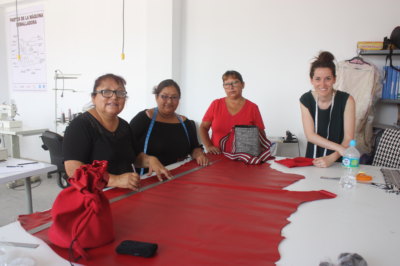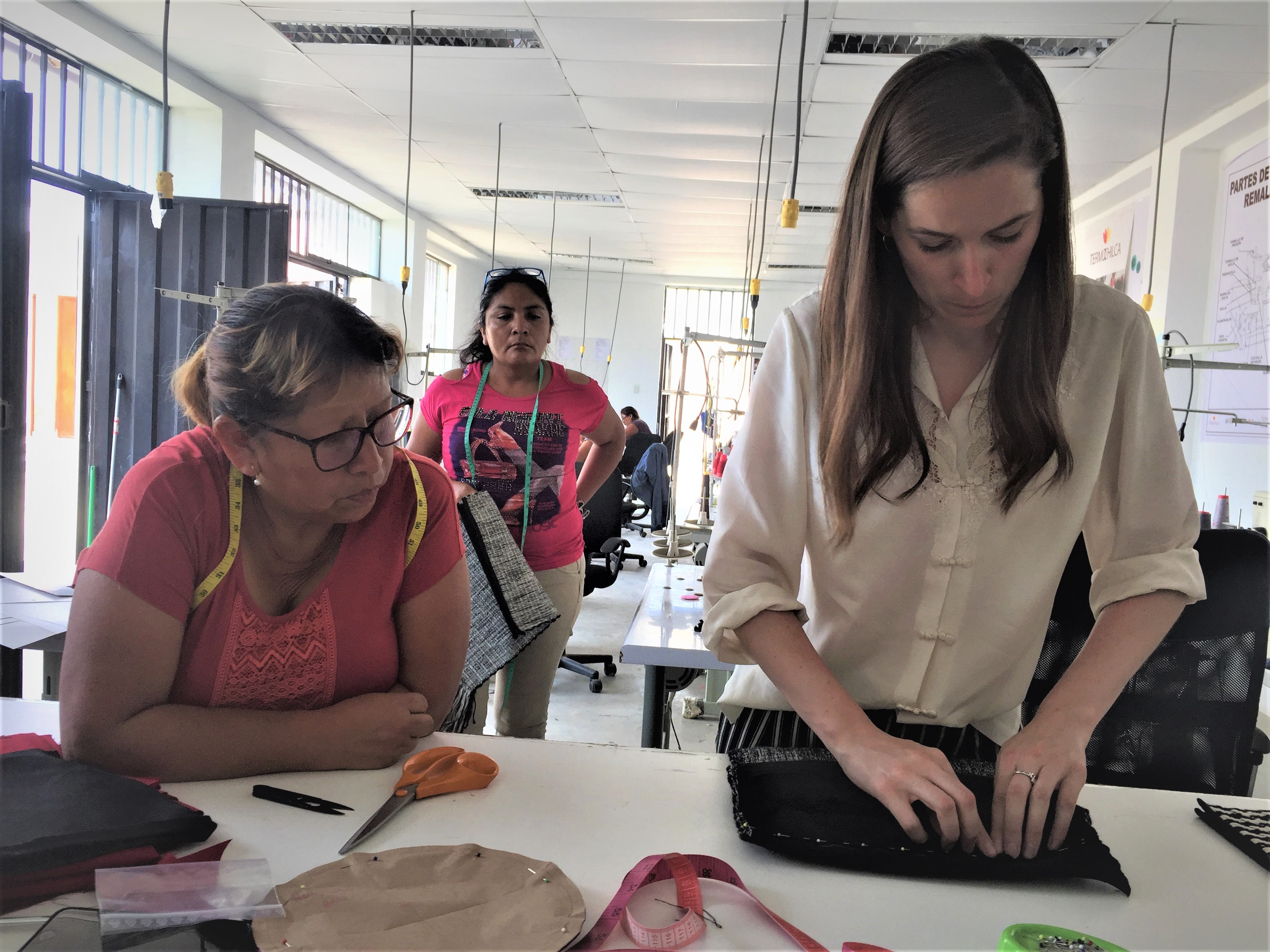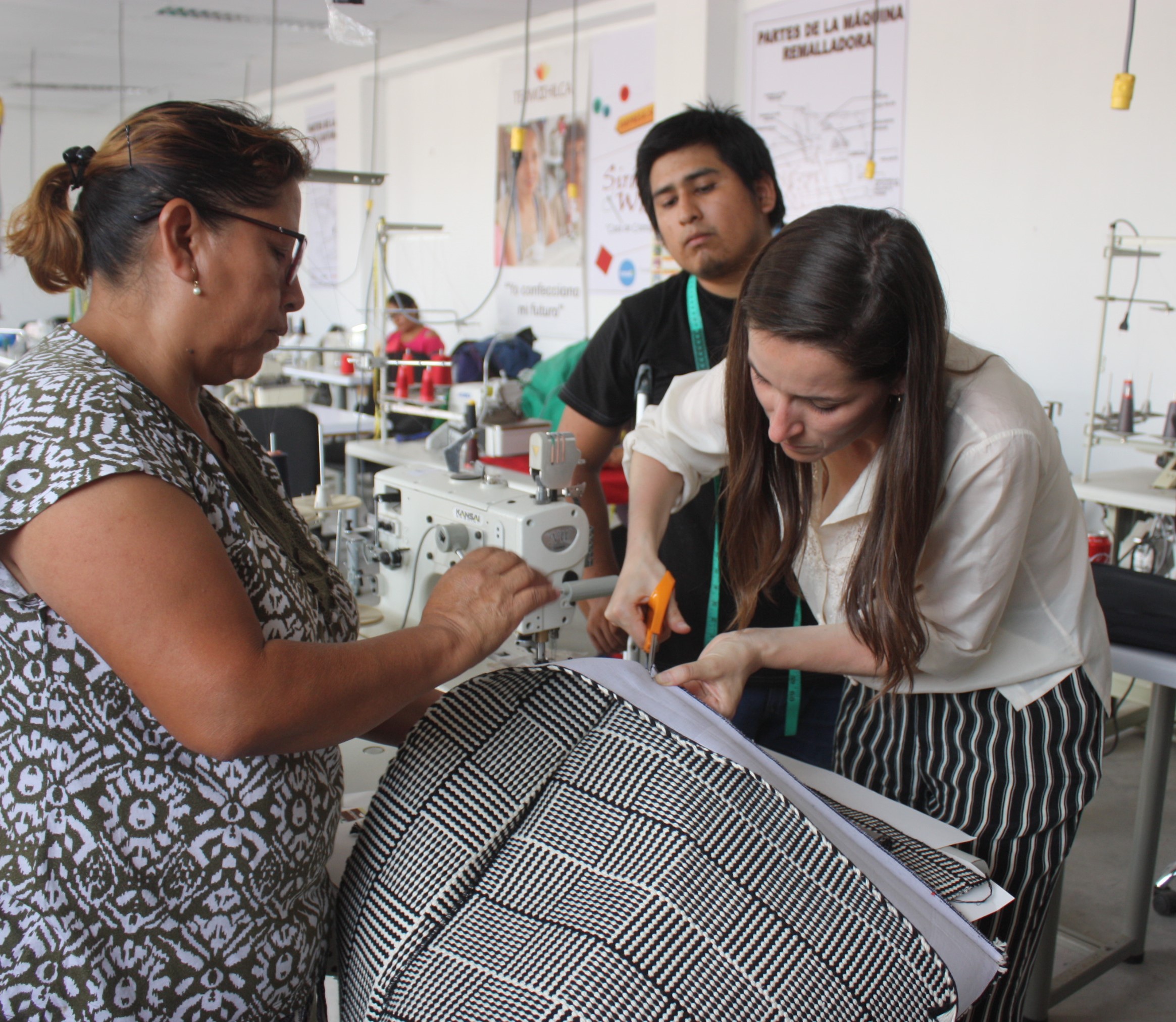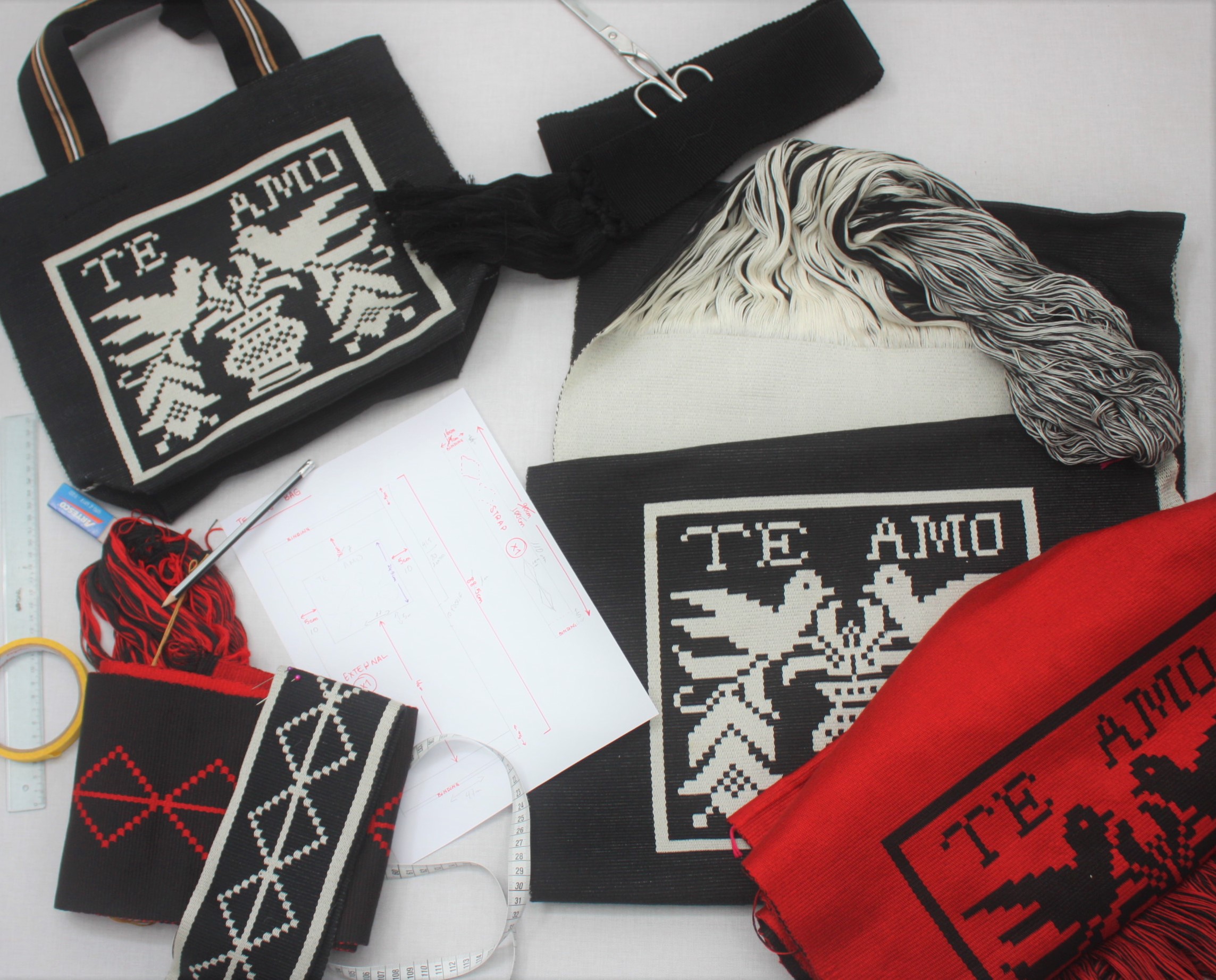In Their Words: Carla Louise Murphy, Pattern Cutter for a Kering Fashion House, and Marta Castañeda, Founder of Pais Textil Describe Their Fellowship Together in Peru

To Make Pais Textil the best it can be, Marta asks the big questions
Marta: Pais Textil is a company that was born as a pilot project whose objective was to sell the pieces woven by the craftspeople we had trained, in the international market. For close to five years, we had been training local women in fine weaving in back strap loom and knitting and help the artisans access the Peruvian market. But we found it difficult for the women to access a market that could pay for the quality of their work, which was cost prohibitive for people in local surrounding villages. In addition, the women had the ability to produce far more than we were able to sell in Perú alone. For these reasons, we decided to expand the range of our work.
But then followed a period of doubt and questioning. The first question we asked ourselves was: what is the market we want to reach? And then: what is this market looking for? What can we offer? So we decided to design products that always have an Andean root, but that would be characterized by a contemporary design, which would allow us to reach more people – more than we would using very ethnic pieces featuring traditional Andean designs.
Since then, we have been working to answer these questions. While not all doubts have been resolved, the visit of Carla Murphy, and the work we have done with her, has opened up a door to new opportunities and ways of considering our product offering. Now, we are seeing the possibilities to grow.
Carla gets to know backstrap and gets inspired by “hidden meanings”
Carla: Let me start by saying that the time I have recently spent in Peru has been my first time in South America, and although very short, has been incredible. I am extremely lucky to have had the opportunity to spend the majority of that time collaborating with Ms. Marta Castañeda, an extraordinary Peruvian woman dedicated to the preservation of the traditional weaving methods of the indigenous people of Peru, and devoted more generally to the empowerment of women.
Throughout my trip, Marta served as a generous wealth of knowledge on the traditional weaving methods used by the indigenous women in Peru. From my first day onward, Marta was an open book, sharing her personal archive of antique woven pieces collected from all across Peru during her many years spent participating in, and establishing, community projects for groups of women. Marta gave me the opportunity to understand the history and culture of woven textiles in the community, which gave important context to our work together.
Marta: The first thing we did with Carla was to show her our raw material – that is, the fabrics. Pais Textil (meaning textile country) fabrics are woven in two textile techniques: back strap loom (pre-Hispanic and almost 5,000 years old) and pedal loom (which arrived in America with the Spaniards), and with two materials: pima cotton and alpaca. Then I showed Carla some of the pieces of my collection of contemporary indigenous textiles, because it was important that she saw what characterizes us and also what differentiates us – in other words, our competitive advantage.
Carla: The backstrap loom is an important part of Peruvian identity mainly practiced in the Andes and rural parts of the country. I learned that for the indigenous communities, weaving has historically been a way to communicate ideas about the natural world, and has also served as a medium for telling stories and recording history. I learned about the winding of the yarn, including tutelage on the meanings behind the symbols woven into each textile. Each piece is unique and filled with hidden meanings.
These “hidden meanings” became inspiration for the collection “Huayruro”. The huayruro plant is native to Peru and an important part of Peruvian culture. There is a traditional belief that the red and black seeds from the plant have the power to bring good fortune, fertility and happiness. We incorporated the colours of the seed into the collection, and also utilized a bird motif, another symbol of fertility in the ancient Peruvian culture.
Taking it back to basics with pattern making
Carla: My work throughout my fellowship project required my close cooperation with two different groups of women – the first group had a weaving workshop in Cajamarquilla and the second maintained a sewing workshop in the Chilca District. Both workshops are the results of social development projects led by Marta. The weavers meet regularly at the workshop in Cajamarquilla, with women coming to receive direction and materials for new orders. Miriam, the masterweaver, would explain and distribute the work and each woman would calculate and wind the yarn necessary for her order, then taking it home to weave.
My first role was to help create basic paper patterns of both bags and garments, limiting the construction of both categories exclusively to rectangular shaped panels that would be sewn together. This limitation stems from the fact the textiles created by the weavers are entirely made by hand; the backstrap technique that the women have mastered is not designed for the creation of more complex forms.

Sewing in Duna Workshop: Miriam Villalta, Alexander Savedra, Carla Murphy
Marta: We started with some alpaca ponchos. We call them origami ponchos. The fabric was woven in Huancavelica in alpaca and was very thin. Some finishes would be made in mercerized pima cotton in backstrap looms in Lima. Carla worked with the women of a productive development project called Duna. The women of this project live south of Lima in the middle of the desert and the sand dunes. They would be responsible for shaping and sewing the origami ponchos. First, they made origami from the pieces on paper that later reached their original size in tocuyo, the vast cotton fabric, and finally, in soft and thin baby alpaca. The women loved the ponchos: simple, nice, easy to make, and very soft.
Next, we debated whether to try a collection of bags. We used basically rectangular structures. The fabrics would be woven to size and would require almost no cutting. The seams were harvested at the very edge of the fabrics, leaving the natural edges to be seen. We chose fabrics that had been woven in pima cotton mixed with lurex threads in copper and silver, along with red and blue shiny threads. Of course, we kept lots of black and white, a signature of Pais Textil. We call the resulting collection Huayruro, like a jungle seed that is red and black with a white dot and is used to give a lot of luck.
Time to sew…
Carla: Once the textiles were created, my next endeavor was to teach the group of seamstresses how to construct initial samples. I needed to do this in a manner that would allow the women to learn fundamentals that could be applied to future projects. This meant teaching simple, basic techniques, explained and demonstrated clearly, with each step broken down. At the stage at which I am in my career, I am accustomed to creating a variety of complicated patterns for very elaborate gowns, so turning back the dial to basics, was no easy task. In the ateliers I typically work in, I also have the luxury of working with every tool and resource imaginable, while Pais Textil was much more limited in its resources, by contrast.
But Marta and I built a solution centered on my teaching a basic technique that all seamstresses would be able to repeat themselves after my departure. I demonstrated how to create miniature models using paper and sellotape, a simple method I often employ myself as a preliminary way to work out 3-dimensional shapes before putting them to paper. Following this, I explained the concept of adding on seam allowances for sewing, which is necessary to do when calculating the complete measurement of each rectangular panel.
Marta: We always look for simple structures when building pieces, for two reasons: firstly, our products, we believe, should show the fabrics of the weavers, mainly – and secondly, because many of the women who sew have very basic technical qualifications in sewing. But it is not always what is simplest is also easiest. Achieving a beautiful bag under these parameters requires giving attention to the details in the fabric and finishes and also requires more work on the structure. And this what we did.

Sewing in Duna Workshop: Miriam Villalta, Alexander Savedra, Carla Murphy
Bringing it all together
Carla: I found that many of the seamstresses, after learning the technique of the miniature paper models, and seeing the results of what they themselves had created from beginning to end, expressed a noticeable sense of pride and elevated interest in contributing to the problem-solving aspects of the project. I also feel that the new body of knowledge these women were able to quickly absorb and put into motion has the potential to build their confidence in all aspects of their lives.
Now back in Italy, a phrase that I noticed on a poster in the workshop in the Chilca District has remained imprinted in my mind; it read: “Yo confecciono mi futuro”, which translates to “I tailor my future”…..When I consider that many of the women whom I collaborated with have no running water in their homes – some even no electricity – and that many have never received any formal education, I am in awe of the exceptionality of their artisan skills and their determination to “tailor their future”. The intense, and in-depth immersion I have experienced through sharing the “working” lives of these women, has left a life lasting impression on me.
Marta: Working with Carla was fantastic. Not only for her incredible ability to work for hours, but also for her excellent qualification. To systematize processes in the world of artisan production, with groups of men and women immersed in spaces of vulnerability, is always the most difficult challenge to take on. The artisans may be able to achieve magnificent fabrics, but the products that are generated and sewn with these fabrics, are always what create the debate. Artisans do not always believe that strict quality control or the need to repeat the same, identical product (i.e. systematizing work) will allow them to have more work. And of course, this type of rigor requires time. In poverty, time is a very expensive investment. For all of us who work with Carla, seeing the importance that she gives to the quality of the products was fundamental to addressing these unique challenges related to artisan production.
It was essential for the Pais Textil team and for the Duna women’s group, to work with Carla and to learn from all of the experience she has achieving excellent products. Carla taught us not to be overwhelmed by the difficulties that need to be overcome to achieve such high quality, even when the pieces must be done again and again. And so that’s what we did for two weeks with Carla. We can only appreciate the opportunity and generosity of Nest and Kering Foundation for making this possible.

The new “Huayruro” bag line comes to life
Carla: Last but not least, I wanted to mention how these populations have zero waste in their workplaces! Every single material, resource and tool is recycled in some way. Nothing is thrown away and everything can be created by hand by recycling other materials. For example, many of the women’s loom backstraps have been made out of recycled materials, as opposed to reeds or cloth. My admiration and respect goes out to Marta and these women. Thank you Nest and Kering Foundation for this experience.